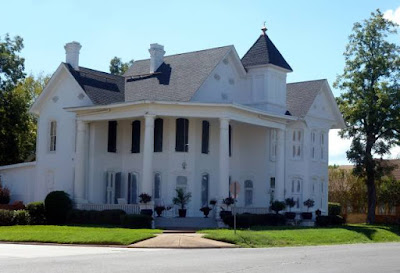San Antonio is one
of the earliest Spanish settlements, centred around a mission built in 1718 on
the banks of the San Antonio River. Travelling in from our campsite we pass
through the usual urban sprawl and confusing road system. Texan drivers take no
prisoners, but the satnav wins through.
Once in the
Downtown area, it’s very pleasant. Even the highrise buildings have an air of
mature elegance.
There is a small
theatre where the stage is on one side of the river and the seating on the
opposite bank. The complete answer to the audience rushing the stage.
The lush greenery
they’ve managed to pack into the walkway is amazing. Jane is looking suitably
flabbergasted.
We stroll past
hotels and the many riverside restaurants. Our goal is on the far side of the
Riverwalk: the Alamo. If one historical building symbolises Texas, this is the
one. I’m looking very proprietorial in the photo, as if I’ve just bought it.
The Alamo mission
church is only part of the complex that grew up from 1718 onwards. Extra
buildings were erected to service the conversion of the local Indians and also
to establishing a Spanish presence in the area.
The mission was
closed in 1793 and taken over by the Spanish military soon after. Part of the
barracks is still standing and is used as a museum. These are the arches
leading into the quarters.
Mexico successfully
fought a war of independence from Spain in the early 1820s, so thereafter
Mexican troops garrisoned the Alamo fort. The new Mexican Government encouraged
settlers from the bordering United States, and copied the American arrangement
where each state had a large degree of autonomy.
In 1833 President
Santa Ana came to power in Mexico. He had different ideas, gradually and
forcefully increasing central control. In 1835 the Texan settlers rebelled,
capturing the weakly defended Alamo. Santa Ana sprang into action and
personally led a force of 2,000 soldiers to re-take the fort. Imagine the 200
Texan volunteers in the Alamo observing the approach of the smart massed ranks
of Mexican regulars. This is a Mexican uniform.
February 1836:
battle commences. The Texans included legendary heroes like Jim Bowie and Davie
Crockett. They had a few cannon, but otherwise relied on primitive weapons such
as these.
The colourful
Mexican army uniforms made good targets for the defenders’ muzzle loading
rifles, demonstrated by the re-enactment Texan Volunteer soldier below, and the
cannon kept the enemy at bay for the time being.
After 13 days, the
weight of numbers triumphed, and the Mexicans broke through; the defenders all
perished.
The church (no
photos inside) is a shrine to the fallen, with the full list of names and flags
representing their place of birth. I was surprised to see a Welsh flag, and
discovered that a certain Lewis Johnson who moved to Texas from Virginia had
been born in Wales. However, they’re now not sure about his birthplace so but
the Welsh flag remains until they decide.
A happy ending to
the Texan uprising in the capture of Santa Ana later that year at the battle of
San Jacinto. Texan independence was granted in exchange for his safe return.
So, all heroed out,
we walk back along the Riverwalk to the car park. We were amused to note that
the ducks have no respect for the exclusive riverbank dining experiences in
their quest for food.
San Antonio
downtown, as they call it- the old part in other words- had more character than
most American cities because of its history and the Riverwalk, a real gem.
























































